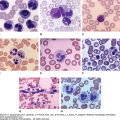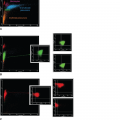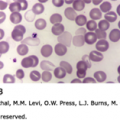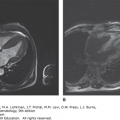INTRODUCTION
SUMMARY
The spleen culls aged and abnormal cells from the blood; removes intraerythrocytic inclusions through a process called pitting; sequesters approximately one-third of the normal intravascular platelet pool; removes bacteria, foreign particles, and tumor cells from the blood; and by virtue of the T and B lymphocytes and macrophages in the white pulp, plays a role in immune surveillance and antibody formation. Splenomegaly can occur as a result of vascular engorgement or cellular infiltration, and it is frequently associated with a combination of neutropenia, thrombocytopenia, and anemia. Hypersplenism is defined as one or more blood cytopenias in the setting of splenomegaly. Hypersplenism can occur with moderate or minimal splenic enlargement as a result of exaggerated removal of physically abnormal (e.g., as in hereditary spherocytosis) or antibody-coated blood cells (e.g., as in autoimmune hemolytic anemia). The presence of splenomegaly in a patient with blood cytopenias is useful to narrow the cause of the cytopenias, although the cause of the blood cytopenias may not be solely or principally as a result of hypersplenism (e.g., as in hairy cell leukemia). Thrombocytopenia in the setting of cirrhosis and splenomegaly is the result of pooling in the enlarged spleen and a relative decrease in thrombopoietin. The role of the spleen in the anemia and neutropenia associated with cirrhosis with splenomegaly is poorly understood, but a relative reduction in erythropoietin levels and decreased marrow myeloid progenitor cells have been proposed. Splenectomy has been used in cases of severe thrombocytopenia requiring chronic platelet transfusions or leading to bleeding. Thrombopoietin receptor agonists are another option in the management of thrombocytopenia, and nonpeptide thrombopoietin receptor agonists have been shown to increase platelet counts in patients with thrombocytopenia associated with hepatitis C virus–related cirrhosis and splenomegaly. Splenectomy may be justified in the case of massive splenomegaly, infarction, or disabling symptoms of pain and compression of neighboring structures. In some circumstances, benefit can be achieved by partial destruction of splenic tissue by embolization using intraarterial infusion of gel microparticles. Hyposplenism can result from agenesis, atrophy, surgical removal of the spleen, or reduction of splenic function by disease. In the latter case, disturbance in splenic circulation disrupts the specific architecture required for the spleen’s culling, phagocytic, and pitting functions. Hyposplenism may be suspected by alterations in red cell morphology, such as target cells or acanthocytes; red cell inclusions, specifically Howell-Jolly and Pappenheimer bodies (siderotic granules highlighted with polychrome stains); pitted red cells; or an elevated platelet count. The presence of pitted red cells identified by interference-contrast microscopy is perhaps the most specific blood finding of hyposplenism, followed by Howell-Jolly bodies. The most devastating consequence of hyposplenism is sudden overwhelming sepsis by encapsulated bacteria. Immunizations and prophylactic antibiotics can decrease the risk of sepsis. A high awareness and prompt antibiotic treatment of febrile episodes are warranted.
Acronyms and Abbreviations:
G-CSF, granulocyte colony-stimulating factor; Ig, immunoglobulin; TPO-RA, thrombopoietin-receptor agonist.
HYPERSPLENISM
The spleen has intrigued physicians and philosophers since ancient times1 and has been assigned mysterious powers, but its association with destruction of blood cells was not elucidated until the turn of the 20th century. The exaggerated and unfounded worry about somatic complaints often reflected by the sense of pain in the spleen (left hypochondrium) led to the term hypochondriac. In 1899, Chauffard proposed that increased splenic activity causes hemolysis.2 This proposal provided the impetus for therapeutic splenectomy, which was performed first in 1910 by Sutherland and Burghard3 in a patient with splenic anemia (hereditary spherocytosis) and subsequently by Kaznelson4 in a patient with essential thrombocytopenia (immune thrombocytopenic purpura) in 1916.
Hypersplenism is defined as blood cytopenias in the setting of splenomegaly. This is usually accompanied by hyperplasia of the affected cell precursors in the marrow. There can be a disproportional decrease in the blood platelets, white cells, and red cells, with thrombocytopenia and leukopenia being disproportionate to the anemia as a result of hypersplenism. Splenomegaly can occur as a result of elevated splenic venous pressures and vascular congestion, histiophagocytic hyperplasia, other cellular infiltration, or because of the inability of physically abnormal red cells, such as sickle cells in infants and children (prior to infarction atrophy), or antibody-coated cells, such as in autoimmune hemolytic anemia, to navigate the circulation or avoid engulfment by the mononuclear phagocyte population of the normal spleen.5 The blood cytopenias are not generally corrected by relief of portal hypertension.6,7
The embryonic spleen appears in the first trimester of gestation as a multiply lobulated condensation of highly vascular mesenchymal cell aggregates interposed in the arterial circulation in the dorsal mesogastrium. The full scope of the molecular basis of splenic organogenesis is not known. The HOX11 and WT1 genes are essential for its formation, and defects in their expression result in hyposplenia or asplenia.8,9,10
The lymphoid compartment, the white pulp, begins its development early in the second trimester of gestation, when mature T cells, principally CD4+ lymphocytes, form a continuous layer along the length of the vessels (periarteriolar sheaths). CD8+ cells reside in splenic cords and a specialized subset of γδT cells home to the pulp (Chap. 6). Immunoglobulin (Ig) D+ and IgG+ B lymphocytes form localized deposits, the primary lymph follicles. Secondary follicles arise later in life, after exposure to immunologic stimuli, and have a distinctive structure that includes a germinal center, a mantle zone, and a marginal zone containing IgM+ and IgG+ B lymphocytes.11,12
The normal adult spleen weighs 135 ± 30 g and has a blood flow that is approximately 5 percent of the cardiac output. In addition to serving as a filter, the spleen plays a role in innate and adaptive immunity and protection against microbes. The spleen is composed of white pulp, a marginal zone, and red pulp. The spleen’s principal structure is organized around an arborizing array of arterioles that branch and narrow until they terminate in either (1) the stroma of cords, forming the open circulation, or (2) the sinusoids, forming the closed circulation of the spleen (Chap. 6). The cordal elements include histiocytes, antigen-presenting cells, pericytes, fibroblasts, and other cells necessary to maintain the discontinuous basal lamina that separates cords from sinusoid lumen.13 Lymphatic tissue is inconspicuous and found in T-cell–rich zones in the periarteriolar lymphoid sheaths.
The arterial vascular tree, which is lined by conventional CD31+ and CD34+ endothelial cells, branches into arterioles that terminate abruptly in caps of cordal macrophages. Blood cells must pass clusters of macrophages to enter the sinusoids.13 The sinusoids, the origin of the venous circulation, are lined by specialized cells having combined phagocytic and endothelial activities and a distinctive CD31+, CD34−, CD68+, CD8+ phenotype. A principal function of the spleen is to serve as a filter, removing aged or defective red cells and foreign particles by macrophages. This function is facilitated by diverting part of the splenic blood supply into the red pulp, where the blood slowly percolates through the nonendothelialized mesh studded with macrophages. Abnormal or senescent red cells and pathogens undergo phagocytosis by the macrophages. The blood then reenters the circulation through narrow slits, measuring 1 to 3 μm, in the endothelium of the venous sinuses. The bulk of the blood is rapidly channeled through vessels that link the arterioles with the venous sinuses. This blood is not filtered or modified.14
Approximately one-third of platelets are normally sequestered in the spleen.15 In many animals, such as dogs and horses, the red pulp is a reservoir for red cells, and splenic contraction provides the red cell volume with a functionally important boost.16 In humans, however, the splenic capsule is poorly contractile, and the spleen does not store red cells to any significant degree.17 Although margination of neutrophils occurs in the spleen, it is unclear to what degree it occurs in that site.18 Granulocyte colony-stimulating factor (G-CSF) administered to cirrhotic patients caused a rise in the blood neutrophil count; thereafter, indium scans of the spleen were performed, which did not show significant uptake by white cells.19
The slow transit of blood through the red pulp permits macrophages to recognize and destroy antibody- or complement-coated red cells and microorganisms, and to ingest poorly deformable red cells or particles retained mechanically by the narrow exit slits in the venous sinuses. The white pulp plays a major role in adaptive immunity. The spleen is involved in the phagocytosis of encapsulated bacteria including Streptococcus pneumoniae, Haemophilus influenzae, and Neisseria meningitidis.
Filtration and elimination of defective cells occur notably in hereditary abnormalities of the red cell membranes, such as spherocytosis, elliptocytosis, or stomatocytosis, or with antibody-coated red cells, neutrophils, or platelets. In these circumstances, cytopenias of varying severity may ensue. The spleen not only removes antibody-coated cells, but also produces antibodies, especially antiplatelet antibodies.20 Thus, the benefits of splenectomy in immune thrombocytopenic purpura is a result of both the decreased production of antiplatelet antibodies as well as decreased clearance by macrophages of antibody-coated platelets through the Fc recognition function of its large macrophage population.
Splenomegaly increases the proportion of blood channeled through the red pulp.13,21 Spleen enlargement may result from expansion of the red pulp compartment with increased blood flow; extramedullary hematopoiesis, notable in primary myelofibrosis; hyperplasia or neoplasia involving the white pulp, such as in infectious mononucleosis or lymphoma; or histiophagocytic hyperplasia.
The increased size of the filtering bed is more pronounced when the splenomegaly is caused by congestion as in portal hypertension than when it is caused by cellular infiltration as in leukemias, extramedullary hematopoiesis, or amyloidosis. Even in space-occupying disorders such as Gaucher disease and primary myelofibrosis, splenomegaly may be associated with hypersplenic sequestration of normal cells.
Splenomegaly increases the vascular surface area and thereby the marginated neutrophil pool.18,19 Platelets are especially likely to be sequestered in an enlarged spleen. However, sequestered white cells and platelets survive in the spleen and may be available when increased demand requires neutrophils or platelets, although their release may be slow.22
Some patients with anemia and splenomegaly have a relative erythropoietin deficiency.23 In one study of cirrhotic patients, 30 percent had a blunted erythropoietin response to anemia.24 Dilution of red cells in an expanded plasma volume is another commonly cited cause of a decreased blood hemoglobin concentration,25 although some studies do not demonstrate hemodilution.26 Iron deficiency associated with chronic blood loss, folic acid and vitamin B12 deficiency, and increased red cell destruction are frequently investigated, although rarely found in patients with liver disease.27 Red cells are destroyed prematurely in the red pulp in the setting of splenomegaly, but only rarely does this explain the anemia.28
Varying amounts of erythrophagocytosis are present, reflecting the normal culling of senescent red cells. Erythrophagocytosis increases as a result of hemolytic anemia and viral infections, and in alloimmunized transfusion recipients. Macrophages within the sinusoids contain red cell fragments. When the process is pronounced, the littoral cells become cuboidal and stand out on the basement membrane (“hobnails”). Sickle cell disease and red cell membrane disorders such as hereditary spherocytosis lead to sequestration of the poorly deformed red cells in the cords but little extrasinusoidal erythrophagocytosis is seen, in contrast to immune hemolytic anemia where macrophage erythrophagocytosis is prominent.13
The increased blood flow from an enlarged spleen expands the splenic and portal veins. A significant increase in portal venous pressure may occur when hepatic vessel compliance is decreased, as in cirrhosis or myelofibrosis. This process initiates a vicious cycle in which portal hypertension contributes to splenomegaly, organ enlargement leads to increased arterial blood flow, which, in turn, increases portal pressure.
Table 56–1 lists causes of splenomegaly, and Table 56–2 lists causes of massive splenic enlargement.
1. Congestive a. Right-sided congestive heart failure b. Budd-Chiari syndrome (inferior vena cava and hepatic vein thrombosis) c. Cirrhosis with portal hypertension d. Portal or splenic vein thrombosis 2. Immunologic a. Viral infection i. Acute HIV infection/chronic Infection ii. Acute mononucleosis iii. Dengue fever iv. Rubella (rare except newborns) v. Cytomegalovirus (rare except newborns) vi. Herpes simplex (rare except newborns) b. Bacterial infection i. Subacute bacterial endocarditis ii. Brucellosis iii. Tularemia iv. Melioidosis v. Listeriosis vi. Plague vii. Secondary syphilis viii. Relapsing fever ix. Psittacosis x. Ehrlichiosis xi. Rickettsial diseases (scrub typhus, Rocky Mountain spotted fever, Q fever) xii. Tuberculosis xiii. Splenic abscess (most common organisms are Enterobacteriaceae, Staphylococcus aureus, Streptococcus group D, and anaerobic organisms as part of mixed flora infections) c. Fungal infection i. Blastomycosis ii. Histoplasmosis iii. Systemic candidiasis; hepatosplenic candidiasis | d. Parasitic infection i. Malaria ii. Kala-Azar iii. Leishmaniasis iv. Schistosomiasis v. Babesiosis vi. Coccidioidomycosis vii. Paracoccidioidomycosis viii. Trypanosomiasis (cruzi, brucei) ix. Toxoplasmosis (rare except newborns) x. Echinococcosis xi. Cysticercosis xii. Visceral larva migrans (Toxocara infection) e. Inflammatory/autoimmune i. Systemic lupus erythematosus ii. Felty syndrome iii. Juvenile rheumatoid arthritis iv. Autoimmune lymphoproliferative syndrome (ALP syndrome) v. Hemophagocytic syndrome vi. Common variable immunodeficiency vii. Splenomegaly caused by granulocyte colony-stimulating factor administration viii. Anti-D immunoglobulin administration (RhoGAM) 3. Secondary to hemolysis a. Thalassemia major b. Pyruvate kinase deficiency c. Hereditary spherocytosis d. Autoimmune hemolytic anemia (uncommon) e. Sickle cell disease in early childhood (splenic sequestration) | 4. Infiltrative a. Nonmalignant i. Splenic hematoma (splenic cysts are usually a late complication of a hematoma) ii. Littoral cell angioma iii. Disorders of sphingolipid metabolism 1. Gaucher disease 2. Niemann-Pick disease iv. Cystinosis v. Amyloidosis (light chain amyloid [AL] and amyloid A protein [AA]) vi. Multicentric Castleman disease vii. Mastocytosis viii. Hypereosinophilic syndrome ix. Sarcoidosis b. Extramedullary hematopoiesis i. Primary myelofibrosis ii. Osteopetrosis (childhood) iii. Thalassemia major c. Malignant i. Hematologic 1. Chronic lymphocytic leukemia (especially prolymphocytic variant) 2. Chronic myeloid leukemia 3. Polycythemia vera 4. Hairy cell leukemia 5. Heavy chain disease 6. Hepatosplenic lymphoma 7. Acute leukemia (acute lymphoblastic leukemia/acute myeloid leukemia) 8. Hodgkin lymphoma ii. Nonhematologic 1. Metastatic carcinoma (rare) 2. Neuroblastoma 3. Wilms tumor 4. Leiomyosarcoma 5. Fibrosarcoma 6. Malignant fibrous histiocytoma 7. Kaposi sarcoma 8. Hemangiosarcoma 9. Lymphangiosarcoma 10. Hemangioendothelial sarcoma |
|









